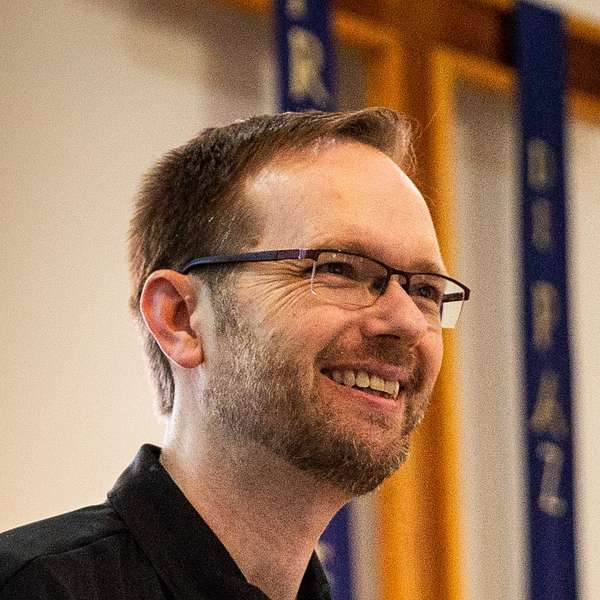
In the Way with Charles St-Onge
In the Way with Charles St-Onge
Building on the Cross
Humanity is torn down to the ground at the cross. We are revealed to be the sinners we are. Cowards, like the disciples. Helpless, like the women on Golgotha. Indifferent, like the crowds. Self-righteous, like the religious leaders. Cruel and callous, like Pilate and the soldiers. A good and all powerful God should fix this. But “fix” means to start over. Everything must die. Including God's Son.
Check us out at ascensionlutheran.ca and intheway.org.
I have a confession to make. I have made it before but I freely make it again. I would have a hard time believing in God were it not for Christ, his crucifixion, and his resurrection. There’s just not a lot of evidence out there. In fact, what evidence there is seems to point in the opposite direction. First, there’s the level of evil and cruelty in the world. Then there’s natural evil: disease, earthquakes, storms, poisonous snakes, etc. What kind of God would permit all of that?
Philosophers have stated the conundrum this way:
- God is good
- God is all powerful
- The world is very evil.
How can all three of these be true at once? Either God is good but not all powerful so there is evil. Or God is all powerful and there is evil so God is not good. Is there some other resolution to the paradox? Yes, there is. For me, that resolution is called “Good Friday.”
Elie Wiesel was a Jewish survivor of the holocaust. He was at Auschwitz, the infamous Nazi concentration camp. In his book “Night,” which Olivia had to read in high school, Wiesel tells this story. “Three men were hung by the Nazis, one of them just a teenage boy. They had been accused of blowing up a power station. In order to warn the other inmates of the high cost of resistance, all the inmates were forced to walk by and see the execution at close range. By the time Wiesel marched by, the two adults were dead. But the youth was still alive, hanging on the gallows, struggling between life and death. Wiesel heard a man ask: “Where is God now? Where is He?” Wiesel said, “I heard a voice within me answer him: Where is God? He is there, hanging on the gallows.”
(https://doubtersparish.com/wp-content/uploads/2020/10/The-Crucified-God.pdf).
Christians often focus on the miracle of the resurrection for “proof” of God’s existence. But in and of itself it doesn’t resolve the great conundrum. Only paired with the evil of the passion of Jesus does a resolution appear. Remember: the question is not whether “God is all powerful.” The question is not whether God is good. The question is whether he can be called good and all powerful at the same time. In other words, what do we do with evil?
Even God himself could not enter creation without suffering and dying. Where is God? He is there, on a cross of wood, nails through his wrists and ankles, stripped naked, hanging derelict and still. It is why the symbol of Christianity is NOT an empty tomb or an empty cross. It is not a big banner that says “God is good” or “God is powerful.” It is God, dying on a tree, uplifted for the world to see in strangest victory.
Where is God when I’m diagnosed with cancer? When I’ve lost my job? When my savings have been stolen by some internet crook? When my daughter won’t speak to me or my mother has left me or my uncle has assaulted me? He is with us. He understand us. He is alongside of us. Because the God who is good and who is all powerful stood with us in our suffering and by so doing, saved the world. He saved you. He saved me.
Danylo Nikitskyi and Alina Kucenko, both fifteen, got together for a walk in the park near their homes in Ukraine. They were two of twenty who were killed when a Russian missile hit Kryvyi Rih in early April. Where was God then? Where is God now? Despised, forsaken, stripped and crucified.
Two armies struggle for control of the African nation of Sudan, bringing hundreds of thousands of women, men and children to the brink of starvation. We could feed them. We choose not to. How can we reconcile this with a good and all-powerful God? Because he allowed us to treat him as we continue to treat our fellow human beings.
There is no path to victory over sin and Satan that does not lead through death. There can be no Last Day resurrection without the cross. There is no “fix” to evil other than complete eradication. And that is what Christ offered in his death.
Conclusion
The schools of Middletown, Ohio were in bad shape. You can ask Deb about their condition– she graduated there, and then when on to teach there for several years. The schools – like our kitchen – needed a “fix.” But the cost of fixing the aged buildings was astronomical. (Think of the millions of dollars of repairs needed for 24 Sussex). There was a better and less expensive solution. Tear them all down and build new.
Humanity is torn down to the ground at the cross. We are revealed to be cruel and indifferent and cowardly sinners. Cowards, like the disciples. Helpless, like the women on Golgotha. Indifferent, like the crowds. Self-righteous, like the religious leaders. Cruel and callous, like Pilate and the soldiers.
A good and all-powerful God should fix this. But “fix” means to start over. Everything must die. Including God. So that by his death we might die to sin, and… as we will soon celebrate… by his resurrection do away with evil once and for all.
This is the rock on which I build my faith. The rock of a crucified Lord, a man and our God, Jesus the Christ. Amen.